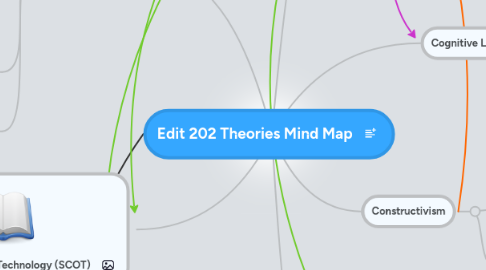Edit 202 Theories Mind Map
Scott Harrisonにより


1. Social Construction of Technology (SCOT)
1.1. It is controlled by the people and builds the success through actual construction or manipulation of the medium/s used by learners
1.2. The premiss I like is the organic nature of the theory. It is human in process as it grows as we nurture it in our own experience. We can use it to build our own structure as it has no confines.
1.3. The limitations are social
2. Media Ecology ,
2.1. http://www.media-ecology.org/publications/MEA_proceedings/v1/McLuhan_and_media_ecology.html
2.2. McLuhan and Media Ecology by Paul Levinson
2.3. One person’s gravity is another’s plodding. The playfulness of McLuhan—his zest for coming up with new ideas or new ways of presenting old ones, rather than exhaustively rehashing the ones already in hand—was one of the prime targets of his critics. The academic world expects documentation, not word plays and analogy. But words in all their glory were important to McLuhan, if only because they, too, are a crucial medium of communication.
2.4. Loved this quote in the paper. I thought it sums up a lot of what I do with social media/ ecology. The fact that reinventing the wheel is an archaic way of thinking. The fact is though some of us need too, to make the next original ideas/ concepts/projects and research valid in the age of technology/teachology.
2.5. the theory is sound because we cannot define it yet. Nor will we.
3. TPACK
3.1. tpack
3.2. Content= what you know and the level you know it too. beginner/ intermediate/ advanced/ expert
3.3. Pedagogy =method of teaching people with technology. Making sure you have relevant tech for the subjects you cover. You cannot use it for show it needs strong content to be valid.
3.4. Technology= itself... What I mean is the fact that without the other two it is irrelevant. It is so important to understand a topic before introducing technology to it. If you don't, then you are potentially falsifying your content towards students or not giving the subject due diligence.
4. Connectivism,
4.1. Get started now!
4.2. understanding the networks between different topics and connecting to improve holistic learning.
4.3. Not just Kinestetics of/ for learning but activity is key to this learning strategy.
4.4. Not just by collaboration with same subject teachers, but using the amazing network of experts you have with cross curricular opportunities builds connections for again holistic and sound learning.
5. Constructivism
5.1. Building scaffolds for learning rather than just piling on the info to deconstruct itself eventually.
5.2. Know your students strengths and weakness to build a better approach to the tasks at hand and long term building of the learning platforms.
5.2.1. INS to insert (Windows)
5.2.2. TAB to insert (Mac OS)
5.2.3. ENTER to add siblings
5.2.4. DEL to delete
5.2.5. Press F1 to see all key shortcuts
